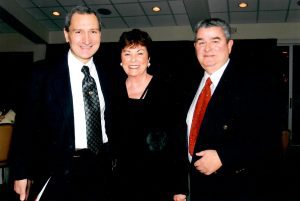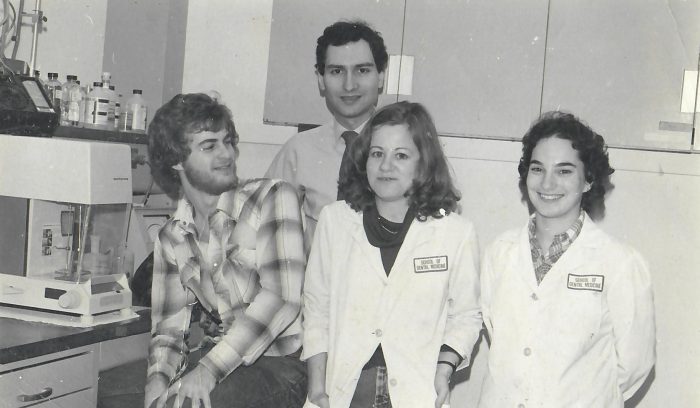By Daniel Dunaief
When Dr. Vincent Iacono first starting teaching at the Stony Brook School of Dental Medicine, he was contemporaries with the students.
That was back in 1974, when Gerald Ford was president, when Post-It Notes were invented and when supermarkets first started scanning bar codes.
A great deal has changed since then. One of the constants over the next half century has been Iacono, who has taught every one of the students who has graduated from the Stony Brook School of Dental Medicine.
“When I started out, the students and I were about the same age,” said Iacono. “Now, I’m like a grandparent to some of the students.”

Iacono, who is the chair of Periodontics and Endodontics and the Director of Postdoctoral Education at Stony Brook School of Dental Medicine, has served in a host of roles at the university as well as in professional societies, gathering appreciative admirers along the way and serving as a skilled local doctor, a leader and role model.
“It’s a remarkable achievement for someone to have touched so many lives as a part of their career,” said Dr. Ira Lamster, a consultant for Santa Fe Group, a think tank dedicated to oral health. Lamster was in the first class to graduate from the Stony Brook School of Dental Medicine in 1977 and served as Dean of the Columbia University College of Dental Medicine.
“I’m proud to have been taught by him,” said Dr. Wayne Aldredge, who works in private practice in Holmdel, New Jersey. Aldredge completed his postdoctoral program at Stony Brook in 1999. Aldredge described Iacono as a “great mentor” and an “encyclopedia of all things related to periodontics and dental implants.”
Indeed, Aldredge suggested that Iacono could “sit down tomorrow and write a paper overnight that would take me three weeks to get done.”
A long-time contributor to education at the dental school, Iacono has earned numerous honors, has served as a clinician and has held a host of leadership positions for national dental groups.
He led the American Academy of Periondotology as president, and was a past Periodontics Commissioner for the Commission on Dental Accreditation. He was also the chair of the Academy of Osseointegration.
Iacono has won numerous awards, including the Isadore Hirschfeld Award and Irwin Scopp Award from the Northeastern Society of Periodontists and the Oral Research Award and Fellowship from the Academy of Osseoointegration. He earned the Distinguished Alumni Award from the Harvard School of Dental Medicine, where he graduated with his DMD in 1972 and earned his Certificate of Periodontology and Oral Medicine in 1974.
“It’s the selfless side of what you do outside school and teaching where he’s had a huge contribution,” said Aldredge.
Building from the beginning
Growing up in Brooklyn and with family who lived in the tri-state area, Iacono was pleased with the opportunity to join Stony Brook after graduating from Harvard.
He felt he was getting in on the “ground floor” and that the early years were an exciting time to build up the school.
“The opportunities continued to grow as I grew in age,” said Iacono.
The Stony Brook School of Dental Medicine is a highly competitive program.
In the class of 2028, the dental school had 1,484 applicants for 46 available spots. The periodontics residency program also had 86 applicants for three spots.
“They want to come here because our dental school’s reputation is phenomenal” and where students get considerable one-on-one interaction with educators, Iacono said.
A defining interaction
When Iacono first started teaching, he was also more involved in research.
Indeed, Dr. Steve Zove, Director of Predoctoral Periodontics at Stony Brook School of Dental Medicine, recalls walking into Rockland Hall before the start of the dental program. He was searching for a summer research position. When he introduced himself in the building, the first person he saw directed him to Iacono’s lab, where Iacono did microbiological and immunology research.
“Dr. Iacono is the reason I went into periodontics,” said Zove, who graduated from Stony Brok Dental School in 1983. The two are close friends, with Zove’s children referring to Iacono as “uncle.”
Among many other superlatives, Zove called Iacono one of the”best lecturers he’s ever come across.”
Iacono effectively gets students involved in lectures, sharing anecdotal information while bringing the class together, Zove said.
Educational changes
Indeed, education has changed considerably over the years.
In the earlier days, Iacono used a blackboard and chalk. Now, students can download lectures and presentations from the cloud and take exams electronically.
Iacono appreciates the opportunity to learn from and tap into the expertise of residents, who help him stay up-to-date technologically.
The change in student demographics means that he has sometimes struggled to find a common vocabulary outside the world of dentistry to communicate.
“If I’m lecturing on bone morphology and I’m describing the shape and pattern of bone resorption around a tooth” and he says the bone resorption is in the shape of a moat, some of his students “don’t know what the word ‘moat’ means. I have to explain a castle with a moat and alligators swimming around.”
He has to express terminology in a way that the class as a whole can understand.
Dental advancements
Iacono has seen numerous changes in periodontics, implant dentistry and general dentistry.
Zove recalled that Iacono was one of the first people to go to Sweden in the 1980’s to study dental implants with the late Per-Ingvar Brånemark, who is considered a pioneer in the field.
Dentists have also enhanced their use of technology to regenerate bone lost to disease and to enhance the esthetic outcomes of surgery.
The use of biologics has already increased exponentially in using growth factors and looking at chemical mediators.
Periodontists also classify the stages of gum disease into one, two and three, a system they didn’t have years ago.
Keeping on
Iacono has enjoyed his work and plans to continue with his teaching and clinical efforts.
He knows it’ll be time to consider retiring when residents don’t come to him for advice in their academic or clinical work.
“If I see that I’m not being asked by my colleagues, by residents for assistance, by students to teach, to provide clinical care, to administrators in developing educational tools to comply with the standards, then I’ll know it’s time to fade away,” he said.
After Iacono has spent more than 50 years and plenty of rinse-and-spit moments at Stony Brook, his colleagues say his help and views remain in high demand.
“He’s one of the most respected individuals within our profession,” said Zove. “He’s a go-to person” in numerous roles, including the accreditation process.





